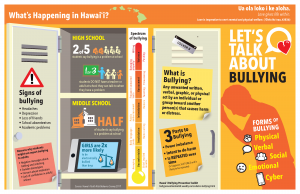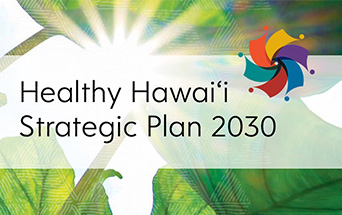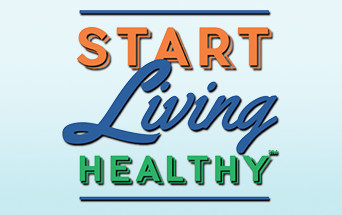School Health
School settings have the potential to play an important role in helping school aged children aged five to seventeen year establish foundational health behaviors in order to adopt lifelong health patterns. Schools provide the optimal learning opportunities to improve educational and health outcomes for young people through advances in policy, environmental, and systems changes. Partnerships between the Department of Health (DOH) and other state and county agencies, the University of Hawai‘i, and other community partners are vital to promote nutrition, physical activity, and tobacco-free lifestyles in school settings.
Improving School Health
Local School Wellness Policy
Every Local Education Agency (LEA) that participates in the National School Lunch Program or other federal child nutrition program is required by law to establish a local school wellness policy for all schools under its jurisdiction. Local wellness policies help to promote student wellness and ensure school meal nutrition guidelines meet the minimum federal school meal standards.
The Hawai‘i State Board of Education Policy 103-1 Health and Wellness, sets forth that the Hawai‘i State Department of Education (HIDOE) shall establish guidelines to ensure compliance with federal school wellness regulations.
Wellness Guidelines
 In 2007, a collaborative effort between the DOH, HIDOE, and community stakeholders resulted in the development of the Wellness Guidelines. The Wellness Guidelines implement Board of Education local wellness Policy 103-1 and fulfill the requirements of Public Law 108-265 Section 204 and the Healthy Hunger-Free Kids Act of 2010. The Wellness Guidelines support a healthy school environment through nutrition criteria for food and beverages that are sold or made available on a school campus, goals for nutrition education, health education, physical activity, physical education, and professional development for staff.
In 2007, a collaborative effort between the DOH, HIDOE, and community stakeholders resulted in the development of the Wellness Guidelines. The Wellness Guidelines implement Board of Education local wellness Policy 103-1 and fulfill the requirements of Public Law 108-265 Section 204 and the Healthy Hunger-Free Kids Act of 2010. The Wellness Guidelines support a healthy school environment through nutrition criteria for food and beverages that are sold or made available on a school campus, goals for nutrition education, health education, physical activity, physical education, and professional development for staff.
School compliance with the Wellness Guidelines is monitored through the annual Safety and Wellness Survey (SAWS). The SAWS fulfills the monitoring requirement of the Board of Education Policy 103-1 and Public Law 108-265, Section 204.
Promoting Healthy Behaviors
Farm to School
Farm to School programs connect students and communities with nutritious local foods, local food producers, and garden education. Farm to School strengthens the local economy, improves the health of communities, and sustains community food systems. Farm to school includes the following core elements:
- Education: Students participate in education activities related to agriculture, food, health or nutrition;
- School Gardens: Students engage in hands-on learning through gardening; and
- Procurement: Local foods are purchased, promoted, and served in the cafeteria as a snack, or taste test.

School Health Surveys
The DOH, the HIDOE, the University of Hawai‘i, and other state and community agencies work together to assess student and school-level health indicators; coordinate school surveys; establish standard survey language and practices; develop summary reports; and disseminate findings. The resulting data provides trend information and guidance for school policy, program development, and evaluation.
Let’s Talk About …
The “Let’s Talk About …” series of infographics was developed by the Hawaii School Health Survey Committee as a user-friendly resource for educators and other adult-allies of youth, who are having important conversations with children, adolescents, and young adults to address some of the critical health concerns in Hawaii. Information is from the Hawaii Youth Risk Behavior Survey and other local data sources. Additional infographics from the national Youth Risk Behavior Survey can be found here.
 |
Download Bullying Infographic
11″ x 17″ PDF (427 kb) |
 |
Download Opioids Infographic
11″ x 17″ PDF (427 kb) |
 |
Download Sugary Drinks Infographic
11″ x 17″ PDF (1.95 mb) |
Youth Risk Behavior Survey
The Youth Risk Behavior Survey measures teen health risk behaviors that contribute to the leading causes of morbidity and mortality among youth and young adults, including: unintentional injuries and violence, mental health and suicide, tobacco and electronic smoking device use, alcohol and other drug use, sexual behaviors related to unintended pregnancy and sextually transmitted infections, weight and nutrition, physical activity, and protective factors.
Safety and Wellness Survey
The Safety and Wellness Survey (SAWS) is used to monitor implementation of the Wellness Guidelines as required by Public Law 108-265, Sec. 204. This annual online survey is jointly administered by the DOH and the HIDOE and is completed by public school principals statewide. Click to view the latest Safety and Wellness Survey results.



